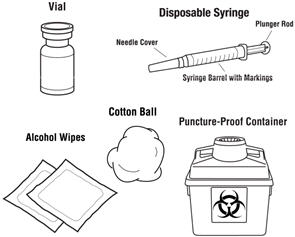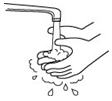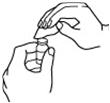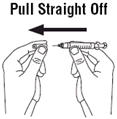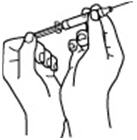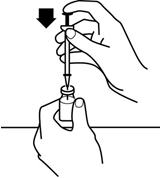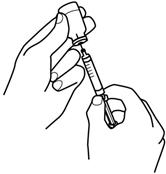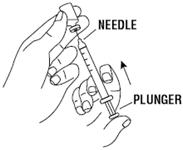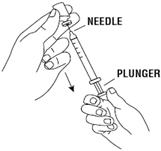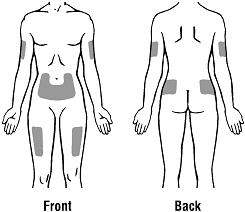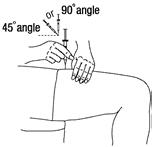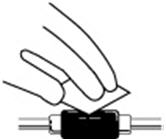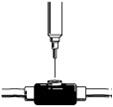RETACRIT™ What do I need to know about the different types of RETACRIT vials?
(epoetin alfa-epbx)
What do I need to know about the different types of RETACRIT vials?
RETACRIT comes in two different types of vials:
- •
- Single-dose vials
- •
- Multiple-dose vials
The multiple-dose vial of RETACRIT contains the preservative benzyl alcohol. Benzyl alcohol has been shown to cause brain damage, other serious side effects and death in newborn and premature babies. RETACRIT that comes in single-dose vials does not contain benzyl alcohol.
Important: Follow these instructions exactly to help avoid infections.
Preparing the dose:
- 1.
- Remove the vial of RETACRIT from the refrigerator. During this time, protect the solution from light.
- 2.
- Do not use a single-dose vial of RETACRIT more than one time.
- 3.
- Do not shake RETACRIT.
- 4.
- Gather the other supplies you will need for your injection (vial, syringe, alcohol wipes, cotton ball, and a puncture-proof container for throwing away the syringe and needle). See Figure 1.
- 5.
- Check the date on the RETACRIT vial to be sure that the drug has not expired.
- 6.
- Wash your hands well with soap and water before preparing the medicine. See Figure 2.
- 7.
- Flip off the protective color cap on the top of the vial. Do not remove the grey rubber stopper. Wipe the top of the grey rubber stopper with an alcohol wipe. See Figures 3 and 4.
Figure 3 | Figure 4 |
- 8.
- Check the package containing the syringe. If the package has been opened or damaged, do not use that syringe. Throw away the syringe in the puncture-proof disposable container. If the syringe package is undamaged, open the package and remove the syringe.
- 9.
- Using a syringe and needle that has been recommended by your healthcare provider, carefully remove the needle cover. See Figure 5. Then draw air into the syringe by pulling back on the plunger. The amount of air drawn into the syringe should be equal to the amount (mL or cc) of the RETACRIT dose prescribed by your healthcare provider. See Figure 6.
Figure 5 | Figure 6 |
- 10.
- With the vial on a flat work surface, insert the needle straight down through the grey rubber stopper of the RETACRIT vial. See Figure 7.
- 11.
- Push the plunger of the syringe down to inject the air from the syringe into the vial of RETACRIT. The air injected into the vial will allow RETACRIT to be easily withdrawn into the syringe. See Figure 7.
- 12.
- Keep the needle inside the vial. Turn the vial and syringe upside down. Be sure the tip of the needle is in the RETACRIT liquid. Keep the vial upside down. Slowly pull back on the plunger to fill the syringe with RETACRIT liquid to the number (mL or cc) that matches the dose your healthcare provider prescribed. See Figure 8.
- 13.
- Keep the needle in the vial. Check for air bubbles in the syringe. A small amount of air is harmless. Too large an air bubble will give you the wrong RETACRIT dose. To remove air bubbles, gently tap the syringe with your fingers until the air bubbles rise to the top of the syringe. Slowly push the plunger up to force the air bubbles out of the syringe. Keep the tip of the needle in the RETACRIT liquid. Pull the plunger back to the number on the syringe that matches your dose. Check again for air bubbles. If there are still air bubbles, repeat the steps above to remove them. See Figures 9 and 10.
Figure 9 | Figure 10 |
- 14.
- Double-check that you have the correct dose in the syringe. Lay the vial down on its side with the needle still in it until after you have selected and prepared your site for injection.
Selecting and preparing the injection site:
RETACRIT can be injected into your body using two different ways (routes) as described below. Follow your healthcare provider's instructions about how you should inject RETACRIT. In patients on hemodialysis, the intravenous (IV) route is recommended.
- 1.Subcutaneous Route:
- •
- RETACRIT can be injected directly into a layer of fat under your skin. This is called a subcutaneous injection. When giving subcutaneous injections, follow your healthcare provider's instructions about changing the site for each injection. You may wish to write down the site where you have injected.
- •
- Do not inject RETACRIT into an area that is tender, red, bruised, hard, or has scars or stretch marks. Recommended sites for injection are shown in Figure 11 below, including:
- o
- The outer area of the upper arms
- o
- The abdomen (except for the 2-inch area around the navel)
- o
- The front of the middle thighs
- o
- The upper outer area of the buttocks
- •
- Clean the skin with an alcohol wipe where the injection is to be made. Be careful not to touch the skin that has been wiped clean. See Figure 12.
- •
- Double-check that the correct amount of RETACRIT is in the syringe.
- •
- Remove the prepared syringe and needle from the vial of RETACRIT and hold it in the hand that you will use to inject the medicine.
- •
- Use the other hand to pinch a fold of skin at the cleaned injection site. Do not touch the cleaned area of skin. See Figure 13.
- •
- Hold the syringe like you would hold a pencil. Use a quick "dart-like" motion to insert the needle either straight up and down (90-degree angle) or at a slight angle (45 degrees) into the skin. Inject the prescribed dose subcutaneously as directed by your doctor, nurse or pharmacist. See Figure 14.
- •
- Pull the needle out of the skin and press a cotton ball or gauze over the injection site and hold it there for several seconds. Do not recap the needle.
- •
- Dispose of the used syringe and needle as described below. Do not reuse syringes and needles.
- 2.Intravenous Route:
- •
- RETACRIT can be injected in your vein through a special access port placed by your healthcare provider. This type of RETACRIT injection is called an intravenous (IV) injection. This route is usually for hemodialysis patients.
- •
- If you have a dialysis vascular access, make sure it is working by checking it as your healthcare provider has shown you. Be sure to let your healthcare provider know right away if you are having any problems, or if you have any questions.
- •
- Wipe off the venous port of the hemodialysis tubing with an alcohol wipe. See Figure 15.
- •
- Insert the needle of the syringe into the cleaned venous port and push the plunger all the way down to inject all the RETACRIT. See Figure 16.
- •
- Remove the syringe from the venous port. Do not recap the needle.
- •
- Dispose of the used syringe and needle as described below.
Find RETACRIT™ medical information:
Find RETACRIT™ medical information:
RETACRIT™ Quick Finder
Health Professional Information
What do I need to know about the different types of RETACRIT vials?
What do I need to know about the different types of RETACRIT vials?
RETACRIT comes in two different types of vials:
- •
- Single-dose vials
- •
- Multiple-dose vials
The multiple-dose vial of RETACRIT contains the preservative benzyl alcohol. Benzyl alcohol has been shown to cause brain damage, other serious side effects and death in newborn and premature babies. RETACRIT that comes in single-dose vials does not contain benzyl alcohol.
Important: Follow these instructions exactly to help avoid infections.
Preparing the dose:
- 1.
- Remove the vial of RETACRIT from the refrigerator. During this time, protect the solution from light.
- 2.
- Do not use a single-dose vial of RETACRIT more than one time.
- 3.
- Do not shake RETACRIT.
- 4.
- Gather the other supplies you will need for your injection (vial, syringe, alcohol wipes, cotton ball, and a puncture-proof container for throwing away the syringe and needle). See Figure 1.
- 5.
- Check the date on the RETACRIT vial to be sure that the drug has not expired.
- 6.
- Wash your hands well with soap and water before preparing the medicine. See Figure 2.
- 7.
- Flip off the protective color cap on the top of the vial. Do not remove the grey rubber stopper. Wipe the top of the grey rubber stopper with an alcohol wipe. See Figures 3 and 4.
Figure 3 | Figure 4 |
- 8.
- Check the package containing the syringe. If the package has been opened or damaged, do not use that syringe. Throw away the syringe in the puncture-proof disposable container. If the syringe package is undamaged, open the package and remove the syringe.
- 9.
- Using a syringe and needle that has been recommended by your healthcare provider, carefully remove the needle cover. See Figure 5. Then draw air into the syringe by pulling back on the plunger. The amount of air drawn into the syringe should be equal to the amount (mL or cc) of the RETACRIT dose prescribed by your healthcare provider. See Figure 6.
Figure 5 | Figure 6 |
- 10.
- With the vial on a flat work surface, insert the needle straight down through the grey rubber stopper of the RETACRIT vial. See Figure 7.
- 11.
- Push the plunger of the syringe down to inject the air from the syringe into the vial of RETACRIT. The air injected into the vial will allow RETACRIT to be easily withdrawn into the syringe. See Figure 7.
- 12.
- Keep the needle inside the vial. Turn the vial and syringe upside down. Be sure the tip of the needle is in the RETACRIT liquid. Keep the vial upside down. Slowly pull back on the plunger to fill the syringe with RETACRIT liquid to the number (mL or cc) that matches the dose your healthcare provider prescribed. See Figure 8.
- 13.
- Keep the needle in the vial. Check for air bubbles in the syringe. A small amount of air is harmless. Too large an air bubble will give you the wrong RETACRIT dose. To remove air bubbles, gently tap the syringe with your fingers until the air bubbles rise to the top of the syringe. Slowly push the plunger up to force the air bubbles out of the syringe. Keep the tip of the needle in the RETACRIT liquid. Pull the plunger back to the number on the syringe that matches your dose. Check again for air bubbles. If there are still air bubbles, repeat the steps above to remove them. See Figures 9 and 10.
Figure 9 | Figure 10 |
- 14.
- Double-check that you have the correct dose in the syringe. Lay the vial down on its side with the needle still in it until after you have selected and prepared your site for injection.
Selecting and preparing the injection site:
RETACRIT can be injected into your body using two different ways (routes) as described below. Follow your healthcare provider's instructions about how you should inject RETACRIT. In patients on hemodialysis, the intravenous (IV) route is recommended.
- 1.Subcutaneous Route:
- •
- RETACRIT can be injected directly into a layer of fat under your skin. This is called a subcutaneous injection. When giving subcutaneous injections, follow your healthcare provider's instructions about changing the site for each injection. You may wish to write down the site where you have injected.
- •
- Do not inject RETACRIT into an area that is tender, red, bruised, hard, or has scars or stretch marks. Recommended sites for injection are shown in Figure 11 below, including:
- o
- The outer area of the upper arms
- o
- The abdomen (except for the 2-inch area around the navel)
- o
- The front of the middle thighs
- o
- The upper outer area of the buttocks
- •
- Clean the skin with an alcohol wipe where the injection is to be made. Be careful not to touch the skin that has been wiped clean. See Figure 12.
- •
- Double-check that the correct amount of RETACRIT is in the syringe.
- •
- Remove the prepared syringe and needle from the vial of RETACRIT and hold it in the hand that you will use to inject the medicine.
- •
- Use the other hand to pinch a fold of skin at the cleaned injection site. Do not touch the cleaned area of skin. See Figure 13.
- •
- Hold the syringe like you would hold a pencil. Use a quick "dart-like" motion to insert the needle either straight up and down (90-degree angle) or at a slight angle (45 degrees) into the skin. Inject the prescribed dose subcutaneously as directed by your doctor, nurse or pharmacist. See Figure 14.
- •
- Pull the needle out of the skin and press a cotton ball or gauze over the injection site and hold it there for several seconds. Do not recap the needle.
- •
- Dispose of the used syringe and needle as described below. Do not reuse syringes and needles.
- 2.Intravenous Route:
- •
- RETACRIT can be injected in your vein through a special access port placed by your healthcare provider. This type of RETACRIT injection is called an intravenous (IV) injection. This route is usually for hemodialysis patients.
- •
- If you have a dialysis vascular access, make sure it is working by checking it as your healthcare provider has shown you. Be sure to let your healthcare provider know right away if you are having any problems, or if you have any questions.
- •
- Wipe off the venous port of the hemodialysis tubing with an alcohol wipe. See Figure 15.
- •
- Insert the needle of the syringe into the cleaned venous port and push the plunger all the way down to inject all the RETACRIT. See Figure 16.
- •
- Remove the syringe from the venous port. Do not recap the needle.
- •
- Dispose of the used syringe and needle as described below.
Health Professional Information
What do I need to know about the different types of RETACRIT vials?
What do I need to know about the different types of RETACRIT vials?
RETACRIT comes in two different types of vials:
- •
- Single-dose vials
- •
- Multiple-dose vials
The multiple-dose vial of RETACRIT contains the preservative benzyl alcohol. Benzyl alcohol has been shown to cause brain damage, other serious side effects and death in newborn and premature babies. RETACRIT that comes in single-dose vials does not contain benzyl alcohol.
Important: Follow these instructions exactly to help avoid infections.
Preparing the dose:
- 1.
- Remove the vial of RETACRIT from the refrigerator. During this time, protect the solution from light.
- 2.
- Do not use a single-dose vial of RETACRIT more than one time.
- 3.
- Do not shake RETACRIT.
- 4.
- Gather the other supplies you will need for your injection (vial, syringe, alcohol wipes, cotton ball, and a puncture-proof container for throwing away the syringe and needle). See Figure 1.
- 5.
- Check the date on the RETACRIT vial to be sure that the drug has not expired.
- 6.
- Wash your hands well with soap and water before preparing the medicine. See Figure 2.
- 7.
- Flip off the protective color cap on the top of the vial. Do not remove the grey rubber stopper. Wipe the top of the grey rubber stopper with an alcohol wipe. See Figures 3 and 4.
Figure 3 | Figure 4 |
- 8.
- Check the package containing the syringe. If the package has been opened or damaged, do not use that syringe. Throw away the syringe in the puncture-proof disposable container. If the syringe package is undamaged, open the package and remove the syringe.
- 9.
- Using a syringe and needle that has been recommended by your healthcare provider, carefully remove the needle cover. See Figure 5. Then draw air into the syringe by pulling back on the plunger. The amount of air drawn into the syringe should be equal to the amount (mL or cc) of the RETACRIT dose prescribed by your healthcare provider. See Figure 6.
Figure 5 | Figure 6 |
- 10.
- With the vial on a flat work surface, insert the needle straight down through the grey rubber stopper of the RETACRIT vial. See Figure 7.
- 11.
- Push the plunger of the syringe down to inject the air from the syringe into the vial of RETACRIT. The air injected into the vial will allow RETACRIT to be easily withdrawn into the syringe. See Figure 7.
- 12.
- Keep the needle inside the vial. Turn the vial and syringe upside down. Be sure the tip of the needle is in the RETACRIT liquid. Keep the vial upside down. Slowly pull back on the plunger to fill the syringe with RETACRIT liquid to the number (mL or cc) that matches the dose your healthcare provider prescribed. See Figure 8.
- 13.
- Keep the needle in the vial. Check for air bubbles in the syringe. A small amount of air is harmless. Too large an air bubble will give you the wrong RETACRIT dose. To remove air bubbles, gently tap the syringe with your fingers until the air bubbles rise to the top of the syringe. Slowly push the plunger up to force the air bubbles out of the syringe. Keep the tip of the needle in the RETACRIT liquid. Pull the plunger back to the number on the syringe that matches your dose. Check again for air bubbles. If there are still air bubbles, repeat the steps above to remove them. See Figures 9 and 10.
Figure 9 | Figure 10 |
- 14.
- Double-check that you have the correct dose in the syringe. Lay the vial down on its side with the needle still in it until after you have selected and prepared your site for injection.
Selecting and preparing the injection site:
RETACRIT can be injected into your body using two different ways (routes) as described below. Follow your healthcare provider's instructions about how you should inject RETACRIT. In patients on hemodialysis, the intravenous (IV) route is recommended.
- 1.Subcutaneous Route:
- •
- RETACRIT can be injected directly into a layer of fat under your skin. This is called a subcutaneous injection. When giving subcutaneous injections, follow your healthcare provider's instructions about changing the site for each injection. You may wish to write down the site where you have injected.
- •
- Do not inject RETACRIT into an area that is tender, red, bruised, hard, or has scars or stretch marks. Recommended sites for injection are shown in Figure 11 below, including:
- o
- The outer area of the upper arms
- o
- The abdomen (except for the 2-inch area around the navel)
- o
- The front of the middle thighs
- o
- The upper outer area of the buttocks
- •
- Clean the skin with an alcohol wipe where the injection is to be made. Be careful not to touch the skin that has been wiped clean. See Figure 12.
- •
- Double-check that the correct amount of RETACRIT is in the syringe.
- •
- Remove the prepared syringe and needle from the vial of RETACRIT and hold it in the hand that you will use to inject the medicine.
- •
- Use the other hand to pinch a fold of skin at the cleaned injection site. Do not touch the cleaned area of skin. See Figure 13.
- •
- Hold the syringe like you would hold a pencil. Use a quick "dart-like" motion to insert the needle either straight up and down (90-degree angle) or at a slight angle (45 degrees) into the skin. Inject the prescribed dose subcutaneously as directed by your doctor, nurse or pharmacist. See Figure 14.
- •
- Pull the needle out of the skin and press a cotton ball or gauze over the injection site and hold it there for several seconds. Do not recap the needle.
- •
- Dispose of the used syringe and needle as described below. Do not reuse syringes and needles.
- 2.Intravenous Route:
- •
- RETACRIT can be injected in your vein through a special access port placed by your healthcare provider. This type of RETACRIT injection is called an intravenous (IV) injection. This route is usually for hemodialysis patients.
- •
- If you have a dialysis vascular access, make sure it is working by checking it as your healthcare provider has shown you. Be sure to let your healthcare provider know right away if you are having any problems, or if you have any questions.
- •
- Wipe off the venous port of the hemodialysis tubing with an alcohol wipe. See Figure 15.
- •
- Insert the needle of the syringe into the cleaned venous port and push the plunger all the way down to inject all the RETACRIT. See Figure 16.
- •
- Remove the syringe from the venous port. Do not recap the needle.
- •
- Dispose of the used syringe and needle as described below.
Resources
Didn’t find what you were looking for? Contact us.
Chat online with Pfizer Medical Information regarding your inquiry on a Pfizer medicine.
*Contact Medical Information.9AM-5PM ET Monday to Friday; excluding holidays.
Report Adverse Event
Pfizer Safety
To report an adverse event related to the Pfizer-BioNTech COVID-19 Vaccine, and you are not part of a clinical trial* for this product, click the link below to submit your information:
Pfizer Safety Reporting Site*If you are involved in a clinical trial for this product, adverse events should be reported to your coordinating study site.
If you cannot use the above website, or would like to report an adverse event related to a different Pfizer product, please call Pfizer Safety at (800) 438-1985.
FDA Medwatch
You may also contact the U.S. Food and Drug Administration (FDA) directly to report adverse events or product quality concerns either online at www.fda.gov/medwatch or call (800) 822-7967.
